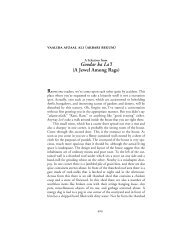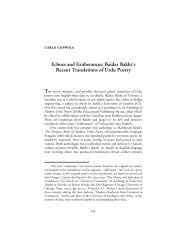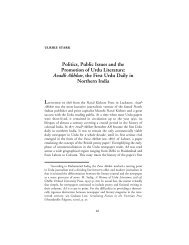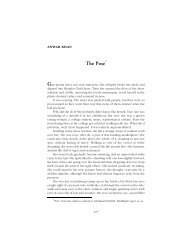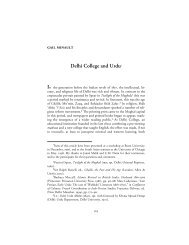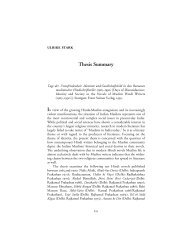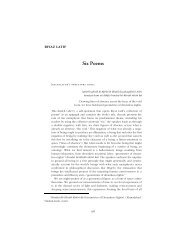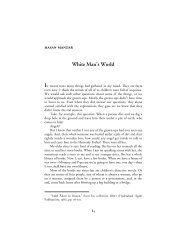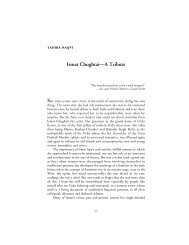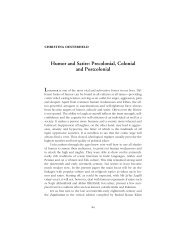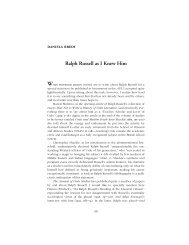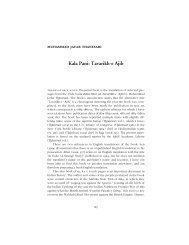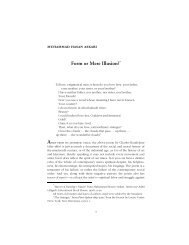The Craft of Naiyer Masud - the Annual of Urdu Studies
The Craft of Naiyer Masud - the Annual of Urdu Studies
The Craft of Naiyer Masud - the Annual of Urdu Studies
You also want an ePaper? Increase the reach of your titles
YUMPU automatically turns print PDFs into web optimized ePapers that Google loves.
Acknowledgement for Images: M.C. Escherís ìHand with Reflecting Sphereî andìSky and Water I.î ©2005 <strong>The</strong> M.C. Escher Company-Holland. All rights reserved.www.mcescher.com.2
John Kenneth Muse • 3john kenneth muse<strong>The</strong> <strong>Craft</strong> <strong>of</strong> <strong>Naiyer</strong> <strong>Masud</strong> *It plays its game out in <strong>the</strong> open, but no one is able tounderstand it. Isnít that something to fear?(<strong>Masud</strong> 2003c, 174)It might seem mildly presumptuous for a non-<strong>Urdu</strong>-reader to analyze<strong>Naiyer</strong> <strong>Masud</strong>ís prose styleóra<strong>the</strong>r like a color-blind person describing arainbow. In <strong>the</strong> case <strong>of</strong> <strong>Masud</strong>, however, reading in translation seemsparticularly appropriate. <strong>Masud</strong>ís style strikes readers as odd and unfamiliarin any language, even his own. <strong>Urdu</strong> readers <strong>of</strong>ten mistake his storiesfor translations from a foreign tongue (Farrukhi 1997, 275). Although<strong>Masud</strong> at times composes first in English or Persian and <strong>the</strong>n translatesback into <strong>Urdu</strong> (Sengupta 1998b, 154), <strong>the</strong> sense <strong>of</strong> dislocation and forebodinghis stories engender arguably has less to do with linguistic or culturaldistance than with his own narrative and stylistic peculiarity. <strong>Masud</strong>takes pains to strip his stories <strong>of</strong> colloquial, idiomatic and figurative language,leaving a spare prose <strong>of</strong> disorienting simplicity and deceptivedepth. Ironically, <strong>Masud</strong>ís careful attention to crafting language producesstories less dependent on a given language. One can find his stories inFinnish or French, English or <strong>Urdu</strong>, yet in any language <strong>the</strong>y feel disorientingless as translations from a foreign tongue than as missives from <strong>the</strong>uncanny, private world <strong>of</strong> <strong>Naiyer</strong> <strong>Masud</strong>.According to Walter Benjamin, <strong>the</strong> ultimate goal <strong>of</strong> a translator is notto transfer information accurately but to ìproduce an echoî <strong>of</strong> <strong>the</strong>untranslatable insights <strong>the</strong> original evokes but can never denote. Translationhighlights <strong>the</strong> remoteness, <strong>the</strong> foreignness <strong>of</strong> all language, measuring<strong>the</strong> distance between words and truths beyond words (1958, 75). If <strong>the</strong>* I am deeply indebted to Pr<strong>of</strong>essor Sara Suleri-Goodyear for introducing meto <strong>Naiyer</strong> <strong>Masud</strong>ís stories and for sharing her insights on his world.
4 • <strong>The</strong> <strong>Annual</strong> <strong>of</strong> <strong>Urdu</strong> <strong>Studies</strong>heart <strong>of</strong> any good translation lies in its ability to echo <strong>the</strong> unsayable,<strong>Masud</strong>ís stories (in <strong>Urdu</strong> as in English) are projects in translation, aimingless to transmit information than to distill untranslatable essences.While <strong>Masud</strong> has inevitably been introduced to <strong>the</strong> West as a ìthirdworldîwriter <strong>of</strong> postcolonial literature, his stories evade such labels as<strong>the</strong>y do genres like realism, modernism, or postmodernism. Sagaree Senguptaclaims <strong>Masud</strong>ís ìtranslated stories bring into ëworld literatureí anaura <strong>of</strong> place, time, and mind without concrete points <strong>of</strong> referenceî(1998a, 82). In o<strong>the</strong>r words, <strong>Masud</strong>ís literature is more o<strong>the</strong>rworldly thanìworld.î One can locate faint pulses <strong>of</strong> socio-political relevance under <strong>the</strong>surface <strong>of</strong> <strong>the</strong> stories. As Zeenat Hisam notes, ì<strong>Masud</strong> chronicles vanishingvalues, fading culture, dying institutions and wi<strong>the</strong>ring relations in asociety in throes <strong>of</strong> change. <strong>The</strong> reader, while traversing <strong>the</strong> narratorísuniverse, feels <strong>the</strong> currents <strong>of</strong> turbulent change underneath <strong>the</strong> calm,shimmering surfaceî (2003, n.p.). Hisam rightly identifies decompositionas a pervasive <strong>the</strong>me for <strong>Masud</strong>; yet to read his stories primarily through asocial or historical lens seems to me an exercise in futility. Many <strong>of</strong><strong>Masud</strong>ís stories document decay, but <strong>the</strong> deteriorations <strong>the</strong>y record areindividual, subjective, or familial ra<strong>the</strong>r than national, and <strong>the</strong> larger socialworld remains a vague intimation. Ignoring ì<strong>The</strong> Myna from PeacockGarden,î exceptional among his stories for its historical markers, I mustagree with Muhammad Umar Memon that <strong>Masud</strong>ís stories fail to ìyield upeven an ounce <strong>of</strong> social usefulnessî (1991, xxix). 1 If Saʿādat Ḥasan ManÅōísstories cannot but be read outside <strong>the</strong> context <strong>of</strong> Partition, <strong>Masud</strong>ís taleselude national or historical readings. Sengupta rightly points out that<strong>Masud</strong>ís works ìembody a wish that <strong>Urdu</strong> literature go beyond Ö obligationsto be a ëthird-worldí literature bringing social problems to <strong>the</strong>attention <strong>of</strong> its readersî (1998a, 88). <strong>Masud</strong>ís tales are riddled with problemsand mysteries, but <strong>the</strong> questions <strong>the</strong> mysteries promptówhat is itpossible to know, what are <strong>the</strong> roles <strong>of</strong> memory and forgetting, what is<strong>the</strong> nature <strong>of</strong> beingórefuse to sit still under cultural or generic labels.Some have been tempted by this fact to dub <strong>the</strong>m ìuniversalî: ìShorn <strong>of</strong>specifics, unanchored in locale, <strong>Masud</strong>ís stories lend <strong>the</strong>mselves to anaura <strong>of</strong> mystery and universalityî (Hisam 2003, n.p.). To my mind, <strong>the</strong>term ìuniversalî carries about as little meaning as its partner, ìworld literature.îIn any case, <strong>the</strong> term cannot be applied to <strong>Masud</strong> without qualification,for his narrative voice seems as eminently unique as it is1 Memonís quotation refers in particular to <strong>Masud</strong>ís story ì<strong>The</strong> Color <strong>of</strong>Nothingness,î but his observation holds for nearly all <strong>of</strong> <strong>Masud</strong>ís stories.
John Kenneth Muse • 5unspecific.If we take seriously <strong>the</strong> notion <strong>Masud</strong>ís work ìdefies any attempt atclassificationî (Memon 1991, xxvi), we are forcedóand liberatedóto lookmore closely at <strong>the</strong> stories <strong>the</strong>mselves. This essay has two parts. <strong>The</strong> firstexplores <strong>the</strong> peculiar and exhilarating effect <strong>of</strong> <strong>Masud</strong>ís sparse prose, aclear yet fragmentary language confounding <strong>the</strong> distinction between plainand complex style. <strong>The</strong> minimalist music <strong>of</strong> his sentences is lucid yet disorienting,grounded in detail yet largely unmoored from geographical orhistorical context. If locations and relationships <strong>of</strong>ten remain fuzzy,crafted objects stand out in sharp focus in <strong>the</strong> myopic, curatorial world <strong>of</strong><strong>Masud</strong>ís fiction. <strong>The</strong> second part <strong>of</strong> <strong>the</strong> essay examines material objectsand images <strong>of</strong> craftsmanship in <strong>the</strong> stories. To linger over made objects in<strong>Masud</strong>ís attentively-crafted tales is to reveal a network <strong>of</strong> reflexive symbolismbeneath <strong>the</strong> narrativeís calm façade.Through a Clear Glass Darkly: <strong>The</strong> Riddle <strong>of</strong> <strong>Masud</strong>’s “Plain Style”I pay great attention to language. I really do ÖI really had to struggle <strong>the</strong>most on language, on how to write precisely, on selecting words thatwould communicate my intent most accurately.ó<strong>Naiyer</strong> <strong>Masud</strong> (Farrukhi 1997, 257)Itís not that I want to inform you about things; thatís not my job.óìSnake Catcherî (<strong>Masud</strong> 2003c, 180)<strong>Masud</strong>ís fiction frustrates conventional dualities like clarity and obfuscation,earnestness and dissimulation, realism and modernism, memory andforgetting. In his stories one enters a world described in clear, unassumingprose that creates a distant and disorienting effect. In ì<strong>The</strong> Myna fromPeacock Garden,î <strong>the</strong> petition writer Amir Ahmad tells Kale Khan, ìMygood man! Why talk in riddles? Use plain language!î (1999, 154). <strong>Masud</strong>ísstories confute this distinction; <strong>the</strong>y are riddles in plain language.Curiously, <strong>the</strong> exhilarating unfamiliarity <strong>of</strong> <strong>Masud</strong>ís work arises from<strong>the</strong> most lucid sentences. Grounded solidly in first-person narration andeconomical description, <strong>the</strong> sparse prose <strong>of</strong> his stories <strong>of</strong>fers little explanationfor <strong>the</strong>ir oddity. Part <strong>of</strong> <strong>Masud</strong>ís fictional project is to tap into <strong>the</strong>potential for straightforward prose to evoke <strong>the</strong> same effects as poeticlanguage without resorting to poetic devices. He uses adjectives andadverbs sparingly, avoids long compound sentences, and very self-consciouslyeschews metaphor, going so far as to claim <strong>the</strong>re is not a single
6 • <strong>The</strong> <strong>Annual</strong> <strong>of</strong> <strong>Urdu</strong> <strong>Studies</strong>metaphor to be found in his work 2 (Sengupta 1998b, 153). <strong>The</strong> result is areserved and reticent surface <strong>of</strong>ten masking pr<strong>of</strong>ound depth. <strong>The</strong> openingparagraph <strong>of</strong> ìObscure Domains <strong>of</strong> Fear and Desire,î <strong>the</strong> first story in<strong>Masud</strong>ís first collection, sets <strong>the</strong> tone for <strong>the</strong> body <strong>of</strong> work to follow: ìIhave given up talking, not looking. It isnít easy to stop looking if onehappens to possess a pair <strong>of</strong> eyes. Keeping quiet, even though one has atongue, is relatively easy. At times I do get <strong>the</strong> urge to close my eyes. Butas <strong>of</strong> now <strong>the</strong>y are still openî (1999, 57ñ58). <strong>The</strong> lines need no syntactic,figurative, or allusive difficulty to be provocative and resonant. <strong>The</strong> firstclause presents <strong>the</strong> logical paradox <strong>of</strong> a narrator talking about his decisionno longer to talk. <strong>The</strong> ostensible obviousness <strong>of</strong> <strong>the</strong> next two sentencesmasks an important distinction between passive sight and activeinsight <strong>of</strong>fered by voluntary silence. Like <strong>the</strong> unnamed narrator <strong>of</strong> thisstory, many <strong>of</strong> <strong>Masud</strong>ís narrators seem to have open eyes and shutmouths. <strong>The</strong>y witness <strong>the</strong> world, but tell <strong>of</strong> it only selectively.On <strong>the</strong> surface, <strong>Masud</strong>ís verbal economy and resistance to stale figurativelanguage recall prose stylists like George Orwell, who condemnsìworn-out metaphors which have lost all evocative powerî (1955, 357).Orwell, though, lobbies for clear language as an aid to clear thought: ìIfone gets rid <strong>of</strong> <strong>the</strong>se habits one can think more clearlyî (ibid., 355). Bycontrast, <strong>Masud</strong>ís formal clarity rarely produces mental clarity: ìTo statethings openly Ö is not <strong>the</strong> job <strong>of</strong> fictionî (Sengupta 1998b, 131). Of course,plain language is rarely as plain as it seems. Hugh Kenner, writing aboutOrwell in ì<strong>The</strong> Politics <strong>of</strong> <strong>the</strong> Plain Style,î explains that plainness <strong>of</strong>fers<strong>the</strong> writer ìa mask <strong>of</strong> calm candor,î disarming <strong>the</strong> reader with its seemingverisimilitude (1985, 52). 3 Kenner puts his finger on <strong>the</strong> potential for unassuminglanguage to dissemble. <strong>Masud</strong>ís narrators <strong>of</strong>ten display a ra<strong>the</strong>ropaque transparency. <strong>The</strong>y give answers to questions, but <strong>the</strong> answershold little meaning:ìWho is it?î2 Despite his resistance to metaphor, <strong>Masud</strong> is not afraid to use similes.Consider <strong>the</strong> three successive similes in <strong>the</strong> last three sentences <strong>of</strong> ìResting Placeî:ìBut when Iím seized by an attack <strong>of</strong> despair, I feel as if tiny yellow leaves arecoming down in a shower between <strong>the</strong> nurse and myself. <strong>The</strong> boy who must ownthis house one day begins to seem like a vanishing shadow. And <strong>the</strong> ceiling <strong>of</strong> myresting place feels like itís right on top <strong>of</strong> my chestî (2003b, 200ñ201).3 I am indebted to Salim-ur-Rahman for connecting Kennerís article and<strong>Masud</strong>ís disarming plainness. See (1997, 291).
John Kenneth Muse • 7I gave her my full name.ìWhere are you coming from?îìIíve been wandering around.î(ìEpistleî 2003a, 208)(ìResting Placeî 2003b, 190)Exploring <strong>Masud</strong>ís stories, <strong>the</strong> reader frequently feels like <strong>the</strong> narrator <strong>of</strong>ìEpistle,î disoriented by an apparently straight path: ìIn my estimation Iwas proceeding along a straight road, but I had <strong>of</strong>ten experienced howseemingly straight roads turned this way or that imperceptibly, throwing<strong>the</strong> wayfarer completely <strong>of</strong>f courseî (2003a, 205). <strong>The</strong> following momentfrom ìSnake Catcherî puts <strong>the</strong> reader inside <strong>the</strong> maze <strong>of</strong> <strong>Masud</strong>ís disorientingirony:ìBe glad that you only encountered questions.î He got up and started topace. ìSuppose <strong>the</strong> questions had also accompanied answers, some <strong>of</strong>which might have <strong>the</strong>mselves been in <strong>the</strong> form <strong>of</strong> questions, and you hadbeen unable to determine which answer went with which question, andwhich question came after which answer or question, and which questionfollowed it, and every time Öî he choked on his words.Is he crying? I wondered and looked at him, but his eyes were dry andhis voice had cleared.ìÖ and every time, when you tried to remember but werenít sure, youwould have regretted remembering even as much as you did,î he said, andit was quite apparent that he was trying to remember something but wasunsure about it.(2003c, 179ñ80)<strong>The</strong> passage is not strictly representative; it is too obviously bewildering.More <strong>of</strong>ten <strong>the</strong> sense <strong>of</strong> confusion in <strong>Masud</strong>ís stories arises graduallythrough <strong>the</strong> accumulation <strong>of</strong> moments both graceful and unextraordinary.Never<strong>the</strong>less, <strong>the</strong> passage works like a <strong>Masud</strong> story in miniature: ostensibleanswers collapse into questions, and what begins as a wise koanunravels into meaninglessness, <strong>the</strong>n chokes into silence, before resumingas a half-forgotten insistence on remembrances better forgotten.In a 1981 essay, ìContemporary Prose Styles,î Annie Dillard separatesall prose into two styles, plain and fancy. At first glance, <strong>Masud</strong>ís proseappears to fit Dillardís description <strong>of</strong> ìplain styleî:This prose is, above all, clean. It is sparing in its use <strong>of</strong> adjectives andadverbs; it avoids relative clauses and fancy punctuation; it forswears
8 • <strong>The</strong> <strong>Annual</strong> <strong>of</strong> <strong>Urdu</strong> <strong>Studies</strong>exotic lexicons and attention-getting verbs; it eschews splendid metaphorsand cultured allusions.(1981, 215)As <strong>the</strong> article continues, <strong>the</strong> resemblance <strong>of</strong> <strong>Masud</strong>ís prose to Dillardíscharacterization <strong>of</strong> ìplain styleî is remarkable:<strong>The</strong> short sentences <strong>of</strong> plain prose have a good deal <strong>of</strong> blank space around<strong>the</strong>m. [Ö] <strong>The</strong>y erupt against a backdrop <strong>of</strong> silence. [Ö] This prose iscraftsmanlike. It possesses beauty and power without syntacticalcomplexity.(ibid., 215ñ17)<strong>Masud</strong>ís prose swerves away from Dillardís category, however, when shediscusses <strong>the</strong> purpose <strong>of</strong> plain writing: ìÖ this prose has one supremefunction, which is not to call attention to itself, but to refer to <strong>the</strong> worldî(ibid., 215). For Dillard, plain prose submits to <strong>the</strong> world by stepping asideto reveal it (ibid., 218). By contrast, fancy or modernist prose piles upbetween <strong>the</strong> reader and <strong>the</strong> world represented, calling attention to itself.If, as Dillard explains, plain prose acts like a hand pointing to objects in<strong>the</strong> world, while modernist prose demands we look at <strong>the</strong> hand itself(ibid., 220), in <strong>Masud</strong>ís stories we see a hand pointing clearly into a bank<strong>of</strong> fog.<strong>The</strong> most vertigo-inducing and, ironically, <strong>the</strong> most characteristicaspect <strong>of</strong> <strong>Masud</strong>ís fiction is its near-total lack <strong>of</strong> context. <strong>Masud</strong> resistsrevealing temporal or spatial coordinates, leaving most characters andplaces without proper names, avoiding idioms or colloquialisms thatmight place speakers in a certain class or region, and rarely includingreligious or cultural identifiers (Farrukhi 1997, 275). <strong>The</strong> narrator <strong>of</strong> ì<strong>The</strong>Color <strong>of</strong> Nothingnessî mentions a time when he was in his ìnonageî(<strong>Masud</strong> 1997, 83); <strong>Masud</strong>ís stories seem to present <strong>the</strong> reader with a nonagein a nonplace. In an eloquent gesture <strong>of</strong> throwing up oneís hands, <strong>the</strong>critic Zeno (Safdar Mir) writes,It is not possible to describe what <strong>the</strong>se stories are like. <strong>The</strong>re are no suchfactors as plots or detailed characters or social or political conditions. Allthat we are made to feel are atmospheres, persons, places and a strongsuggestion <strong>of</strong> things passing, decaying, dying. It is a matter <strong>of</strong> time flowingover cities, houses, people and civilizations.(1997, 302)In fact, <strong>the</strong> stories generally do have definitive times and settings, but <strong>the</strong>ir
John Kenneth Muse • 9narrators suggest <strong>the</strong>m only by implication or fail to mention <strong>the</strong>m at all.Although <strong>Masud</strong>ís hometown, Lucknow, is unnamed in all but a few stories,it remains a central character in his fictional world. <strong>Masud</strong> imagines asetting <strong>the</strong>n chooses to forget it, making his stories clairvoyantlyparochial.<strong>Masud</strong>ís stories, <strong>the</strong>n, are not merely uncontextual, <strong>the</strong>y are decontextualized.As Muhammad Salim-ur-Rahman has thoughtfully discussedin ìOnce Below a Time: A Short Essay on Sīmiyāî (1997), omission plays acentral role in <strong>Masud</strong>ís storytelling. According to <strong>Masud</strong>, all <strong>of</strong> his storieswere originally much longer than <strong>the</strong> published versions. He might writeseventy pages and jettison fifty, paring away not only <strong>the</strong> excess but also<strong>the</strong> essential, removing significant background information or excising aconclusive ending, leaving <strong>the</strong> reader with unanswerable questions (Sengupta1998b, 273). What ìstrange developmentî allowed Bibi to own <strong>the</strong>dock (ghat) in ìSheesha Ghatî? (<strong>Masud</strong> 1999, 90). What dead girl is <strong>the</strong>narrator <strong>of</strong> ìSnake Catcherî running away from as <strong>the</strong> story opens? Whoare <strong>the</strong> visitors in ì<strong>The</strong> Wea<strong>the</strong>r Vane,î and what is <strong>the</strong> fa<strong>the</strong>rís occupation?Without answers to such questions, readers find <strong>the</strong>mselves in <strong>the</strong>position <strong>of</strong> <strong>the</strong> narrator <strong>of</strong> ìObscure Domains <strong>of</strong> Fear and Desire,î pokingaround in spaces operating at <strong>the</strong>ir own peculiar speeds, and looking formeaning in what cannot be seen:Ö I began to concentrate on <strong>the</strong> shapes <strong>the</strong>se invisible parts formed. <strong>The</strong>yshaped <strong>the</strong> outlines <strong>of</strong> different images which, at times, had a truly amazingresemblance to certain objects. But I never found a complete picture <strong>of</strong>anything. Everything appeared incomplete or fragmented, even though Iexamined countless such ìinvisibleî parts. Some <strong>of</strong> <strong>the</strong>se images hadfamiliar shapesó<strong>of</strong> a lion, for instance, or a crab, or a pair <strong>of</strong> scalesóbut<strong>the</strong>y were always unfinished. O<strong>the</strong>r images resembled unknown objectsand even though unfamiliar, still gave a sense <strong>of</strong> being incomplete. <strong>The</strong>yleft a strange effect on <strong>the</strong> mind which was impossible to articulate.(ibid., 71)It is fitting ìObscure Domainsî should ruminate about invisible parts; <strong>the</strong>first drafts <strong>of</strong> <strong>the</strong> story itself were ten times longer than <strong>the</strong> published version.In this sense, <strong>Masud</strong> is a negative craftsman: ìConsider it a tradesecret, but certain things I purposely refrain from mentioning. At times Idonít have <strong>the</strong> whole story in mind. O<strong>the</strong>r times I do, but I leave out substantialparts in <strong>the</strong> finished pieceî (Farrukhi 1997, 271ñ72). Like a sculptorchiseling out a human form, <strong>the</strong>n removing <strong>the</strong> head, perhaps an arm, or
10 • <strong>The</strong> <strong>Annual</strong> <strong>of</strong> <strong>Urdu</strong> <strong>Studies</strong>both feet, <strong>Masud</strong> leaves a finely-wrought piece flaunting its incompletion,and drawing <strong>the</strong> mind to <strong>the</strong> mysterious shapes formed by words withheld.At one point <strong>the</strong> narrator <strong>of</strong> ìObscure Domainsî digresses todescribe an unnamed woman with whom he may or may not have flirted:She was in <strong>the</strong> habit <strong>of</strong> arranging and rearranging her lustrous black hair. Ithought she wanted to draw my attention to it. But she just disappearedone day. I was taken aback. I set out looking for her. [Ö] I never found herand I suspect that <strong>the</strong> fear I induced in her may have been <strong>the</strong> cause <strong>of</strong> herdeath. But I <strong>of</strong>ten console myself with <strong>the</strong> thought that her falling into <strong>the</strong>river was an accident. That she hadnít drowned; sheíd been rescued.(1999, 72)Tucked in a clause at <strong>the</strong> end <strong>of</strong> <strong>the</strong> paragraph, ìher falling into <strong>the</strong> riverîis <strong>the</strong> only mention <strong>of</strong> this event. We are given <strong>the</strong> bare bones <strong>of</strong> a story,but an autopsy cannot confirm <strong>the</strong> cause or circumstances <strong>of</strong> death, oreven whe<strong>the</strong>r <strong>the</strong>re was a death. Who is <strong>the</strong> girl attached to this lustrousblack hair? Why did she disappear? Why did she fall in <strong>the</strong> river? Was sherescued? <strong>The</strong> confusion <strong>of</strong> <strong>the</strong> narrator echoes <strong>the</strong> confusion <strong>of</strong> <strong>the</strong>reader, for <strong>the</strong> womanís story has disappeared as mysteriously as she did.ìSīmiyā,î <strong>the</strong> eponymous story <strong>of</strong> <strong>Masud</strong>ís first collection, evokes<strong>Masud</strong>ís negative craftsmanship in a moment <strong>of</strong> self-referential symbolism.4 In <strong>the</strong> story, a young fugitive takes up residence along with anoccultist in <strong>the</strong> tower <strong>of</strong> an abandoned palace. <strong>The</strong> young man cannotfigure out what disconcerts him about <strong>the</strong> structure until <strong>the</strong> o<strong>the</strong>r mansuggests what is bo<strong>the</strong>ring him is <strong>the</strong> fact that even in ruins <strong>the</strong> palacedoes not look old. In fact, <strong>the</strong> ruined palace is not a ruin at all; ìit hasbeen built to resemble a ruinî (Salim-ur-Rahman 1997, 297). 5 <strong>The</strong> followingexchange clarifies <strong>the</strong> self-reference:ìBut why are you looking so worried?î I asked and didnít know what tosay next. ìWhat is <strong>the</strong>re to feel worried about?îìBecause I would have done <strong>the</strong> same had I built an edifice myself,î he[<strong>the</strong> occultist] said with great conviction.(ibid.)<strong>The</strong> occultist ventriloquizes <strong>Masud</strong>, who himself constructs stories resem-4 <strong>The</strong> first full English translation <strong>of</strong> ìSīmiyāî appears elsewhere in this issue.5 My quotation is from Salim-ur-Rahmanís paraphrase <strong>of</strong> <strong>the</strong> scene, not fromhis translated sections <strong>of</strong> <strong>the</strong> story itself.
John Kenneth Muse • 11bling ruins. He builds a structure, <strong>the</strong>n gradually removes pieces, leavingconspicuous holes and causing <strong>the</strong> whole to teeter precariously. <strong>The</strong>result retains <strong>the</strong> suggestion <strong>of</strong> <strong>the</strong> original shape, but rests only on <strong>the</strong>strongest, most intractable pieces. At times he goes fur<strong>the</strong>r. Omitting <strong>the</strong>most basic elementsónames, places, relationships, background detailsó<strong>Masud</strong> removes <strong>the</strong> foundations <strong>of</strong> his structures, leaving artifacts hoveringin a void.<strong>The</strong> combination <strong>of</strong> close descriptive focus and unclear narrativearchitecture in <strong>Masud</strong>ís narrative has led several critics to compare <strong>the</strong>experience <strong>of</strong> reading <strong>Masud</strong> to a young childís experience <strong>of</strong> <strong>the</strong> world.For Elizabeth Bell, ìwe feel our way through [<strong>Masud</strong>ís stories] like children,unclear on specifics, controlled by various external authority figuresand harboring <strong>the</strong> illusion that someone, somewhere, holds <strong>the</strong> key to <strong>the</strong>puzzle <strong>of</strong> existenceî (1997, 279). Sagaree Sengupta makes a similar comparison,quoting Yi-Fu Tuan, who describes <strong>the</strong> ìyoung childís worldî asone composed <strong>of</strong> ìvivid, sharply delineated objects in a weakly structuredspaceî (1998a, 82). In conversation, <strong>Masud</strong> has exaggerated <strong>the</strong> indistinctness<strong>of</strong> his tales: ìÖ youíll find you donít get a lot <strong>of</strong> details about anyparticular thing in my storiesî (Sengupta 1998b, 125). In fact, <strong>the</strong> detailsgiven in <strong>Masud</strong>ís stories are precisely concerned with particular things,but his lens is alternately in and out <strong>of</strong> focus. Architectural spaces arewell-defined, as are individual objects, but humans and <strong>the</strong> relationshipsamong <strong>the</strong>m remain indistinct (1998a, 83). While conversations carry littlemeaning, objects tell stories. 6 <strong>The</strong> second half <strong>of</strong> <strong>the</strong> essay will look moreclosely at <strong>the</strong> stories told by some <strong>of</strong> <strong>Masud</strong>ís objects. I mention <strong>the</strong> clarity<strong>of</strong> objects and fuzziness <strong>of</strong> background here to underline <strong>the</strong> disorientingchildhood myopia <strong>of</strong> <strong>Masud</strong>ís style.Much <strong>of</strong> <strong>Masud</strong>ís stylistic asceticism arises from his ideas about <strong>the</strong>way fiction should work. He maintains that clarity is not <strong>the</strong> role <strong>of</strong> fiction,and avoids ìstory-likeî stories with clear conclusions (Sengupta 1998b,132). <strong>Masud</strong> does hope his tales communicate something, but in his view<strong>the</strong> communication happens by a kind <strong>of</strong> mental osmosis whereby absentideas insinuate <strong>the</strong>mselves into <strong>the</strong> readerís mind:Ö when you have a very complex, long personal experience and youdescribe it in a plain and straightforward manner, with no details, but wi<strong>the</strong>verything present inside your own mind as you are writing, somehow itreaches <strong>the</strong> reader. Why it reaches <strong>the</strong> reader, through telepathy or some-6 For more on objects in <strong>Masud</strong>, see (Sengupta 1998a).
you on <strong>the</strong> page! 7 (Sengupta 1998b, 143)12 • <strong>The</strong> <strong>Annual</strong> <strong>of</strong> <strong>Urdu</strong> <strong>Studies</strong>thing else, I canít say.(ibid., 125)<strong>Masud</strong> suggests his stories operate subliminally, so while significantdetails remain in <strong>the</strong> authorís head, ì<strong>the</strong> reader feels a palpable sensation<strong>of</strong> something, some story breathing behind all thisî (Farrukhi 1997, 272).Elsewhere, though, he resists <strong>the</strong> idea that meaning crouches in <strong>the</strong>shadows:<strong>The</strong>reís <strong>the</strong> feeling that something major is being signified, but when youscrutinize <strong>the</strong> story no such thing comes out. This is a big problem for me,that lots <strong>of</strong> people complain that <strong>the</strong>y donít understand what Iím trying tosay. Iíve just told a storyówhatís <strong>the</strong>re to understand or not understand?[Ö] Why ask me what I ìsaidî in <strong>the</strong> story? What I said is right in front <strong>of</strong>In both cases, <strong>Masud</strong> seems playfully disingenuous. He pleads ignoranceabout <strong>the</strong> method <strong>of</strong> his stories communicative power, invoking fuzzymetaphysical ideas like telepathy or subliminal suggestion. In fact, <strong>the</strong>re isfar more at work in his stories than straightforward description with nodetails. His tales may have relatively little figurative language, but <strong>the</strong>y arenot without literary device. While individual sentences remain literal, <strong>the</strong>stories teem with tropes like repetition, synecdoche, foreshadowing,andóas <strong>the</strong> next section will discussósymbolism.<strong>Masud</strong>’s Reflexive <strong>Craft</strong><strong>The</strong> little chandelier twirled before my eyes, and everything I saw resembledsome part or aspect <strong>of</strong> it.óìEssence <strong>of</strong> Camphorî (<strong>Masud</strong> 1999, 35)Like origami, <strong>Masud</strong>ís stories are carefully turned in on <strong>the</strong>mselves. <strong>The</strong>y7 <strong>Masud</strong>ís admonishment reminds me <strong>of</strong> <strong>the</strong> program note to E.E. Cummingsíonly full-length play, Him: ìRelax, and give this PLAY a chance to strut its stuffórelax, donít worry because itís not like something elseórelax, stop wonderingwhat itís all ëaboutíólike many strange and familiar things, Life included, <strong>the</strong>PLAY isnít ëabout,í it simply is. Donít try to despise it, let it try to despise you.Donít try to enjoy it, let it try to enjoy you. DONíT TRY TO UNDERSTAND IT, LETIT TRY TO UNDERSTAND YOUî (qtd. in Maurer 1972, 135).
14 • <strong>The</strong> <strong>Annual</strong> <strong>of</strong> <strong>Urdu</strong> <strong>Studies</strong>answer is that ëtrue artí in fiction or poetry amounts only to ten per cent;ninety per cent is pure craftsmanship, work in o<strong>the</strong>r wordsóexamining,writing, rewritingÖî (Sengupta 1998b, 148). <strong>Masud</strong> uses a different ratiothan Edison, for whom genius was one percent inspiration and ninetyninepercent perspiration, but <strong>the</strong> insistence on painstaking, repetitivelabor characterizes both innovators. <strong>Masud</strong> claims it takes him an average<strong>of</strong> four or five months to compose a story (ibid., 159). Over <strong>the</strong> past thirtyfiveyears, he has produced about a story a year. In short, <strong>Masud</strong>approaches his work as just thatóworkóand <strong>the</strong> products <strong>of</strong> his labor<strong>of</strong>fer meditations on <strong>the</strong> process <strong>of</strong> <strong>the</strong>ir own creation.To those familiar with <strong>Masud</strong>ís stories, <strong>the</strong> opening <strong>of</strong> ìEssence <strong>of</strong>Camphorî reads like a manifesto:I never learned <strong>the</strong> intricate, tenuous art <strong>of</strong> perfume making practiced inancient times, now nearly lost or perhaps already extinct; nor am Iacquainted with <strong>the</strong> new methods <strong>of</strong> concocting artificial fragrances. Thisis why no one understands <strong>the</strong> essences I prepare, nor succeeds inimitating <strong>the</strong>m.(1999, 1)<strong>Masud</strong> winks here at his idiosyncrasy. His stories resemble nei<strong>the</strong>r <strong>the</strong>heavily perfumed style <strong>of</strong> classical <strong>Urdu</strong> literature nor <strong>the</strong> concocted artifice<strong>of</strong> many abstract modernist short stories. Instead, like <strong>the</strong> essence <strong>of</strong>camphor, his tales exude a pregnant absence: ìAttempting to smell it onefeels a vacant forlornness, but <strong>the</strong> next time around, breathing deeply,one detects something in this forlornnessî (ibid., 2). <strong>Masud</strong>ís characteristicsynaes<strong>the</strong>sia works here metatextually, rendering <strong>the</strong> act <strong>of</strong> reading intoan inhalation: an immediate, receptive relationship with <strong>the</strong> atmosphere<strong>of</strong> <strong>the</strong> story, producing at first a sense <strong>of</strong> ìvacant forlornness,î and later<strong>the</strong> intuition that something lies behind it. <strong>Masud</strong>ís tales are essences,extracts boiled down from dreams and longer stories into concentratedform. If meaning does not always cohere in <strong>Masud</strong>ís tales, remnants <strong>of</strong> itinhere: ìÖ whatever is revealed in this forlornness already existed before<strong>the</strong> extractís conception. Indeed, <strong>the</strong> preparing <strong>of</strong> <strong>the</strong> extract relies on itsexistenceî (ibid., 3). If much <strong>of</strong> <strong>the</strong> world <strong>of</strong> each story has evaporated,<strong>the</strong> dream behind each remains, quite literally, essential.As ìEssence <strong>of</strong> Camphorî continues, it becomes cluttered with selfreferentialcrafted objects. <strong>The</strong> small, finely-wrought ìcamphor sparrow,îtrapped in time, ei<strong>the</strong>r about to land or just taking <strong>of</strong>f, reminds <strong>the</strong> reader<strong>of</strong> <strong>the</strong> narrative itself, simultaneously alighting on physical details and
John Kenneth Muse • 15detaching itself from <strong>the</strong>m (ibid., 28). Mah Rukh Sultan praises <strong>the</strong> imitationclock made by <strong>the</strong> narrator for its evasion <strong>of</strong> verisimilitude: ìThis oneis much nicer. <strong>The</strong> o<strong>the</strong>r one looked realî (ibid., 29). <strong>Masud</strong>ís stories, too,delight <strong>the</strong> reader because <strong>the</strong>y are just odd enough as representations toappear unreal. Even more evocative is <strong>the</strong> chandelier <strong>of</strong> fragrances MahRukh Sultan gives <strong>the</strong> boy before her death. As a delicate collection <strong>of</strong>distilled essences suspended in space, yet spinning ìslowly and steadilyso that none <strong>of</strong> its parts could be firmly envisionedî (ibid., 35), <strong>the</strong> chandelierresembles <strong>Masud</strong>ís collection <strong>of</strong> stories, each a unique essence,transparent and delicate as glass and yet somehow never clearly envisioned.<strong>The</strong> chandelier also evokes <strong>the</strong> very synecdoche in which it takespart. <strong>The</strong> narrator recalls <strong>the</strong> chandelier and says, ìeverything I sawresembled some part or aspect <strong>of</strong> itî (ibid.). <strong>The</strong> reader could say <strong>the</strong>same <strong>of</strong> <strong>Masud</strong>ís story: every objectó<strong>the</strong> eponymous fragrance, <strong>the</strong> camphorsparrow, <strong>the</strong> clay clock, <strong>the</strong> perfume chandelieróseems a distillation<strong>of</strong> some aspect <strong>of</strong> <strong>Masud</strong>ís project. 9<strong>Masud</strong>ís curatorial bent plays a large role in ìSnake Catcher,î one <strong>of</strong>his earliest stories. Seemingly apropos <strong>of</strong> nothing, <strong>the</strong> jungle reminds <strong>the</strong>narrator <strong>of</strong> a collection <strong>of</strong> curios in <strong>the</strong> outer reception room <strong>of</strong> his house.As <strong>the</strong> narrative focuses on each object, we notice each is incomplete:One was a tiger made <strong>of</strong> some kind <strong>of</strong> metal. It stood on its hind legs withits mouth wide open as though it were roaring. Itís eyes were crafted fromsome precious stone and <strong>the</strong>y had disappeared several generations before9 <strong>Masud</strong>ís love <strong>of</strong> objects and reverential treatment <strong>of</strong> <strong>the</strong> artificial recalls <strong>the</strong>speaker <strong>of</strong> Yeatsís poem ìSailing to Byzantiumî who yearns to translate mere fleshinto ì<strong>the</strong> artifice <strong>of</strong> eternity.î <strong>The</strong> final stanza <strong>of</strong> <strong>the</strong> poem manifests <strong>the</strong> artistísdesire to represent <strong>the</strong> self not through characters, or animals, but through anintricately wrought object <strong>of</strong> art:Once out <strong>of</strong> nature I shall never takeMy bodily form from any natural thing,But such a form as Grecian goldsmiths makeOf hammered gold and gold enamellingTo keep a drowsy Emperor awake;Or set upon a golden bough to singTo lords and ladies <strong>of</strong> ByzantiumOf what is past, or passing, or to come. (1996, 194)Yeatsís golden bird finds cousins in <strong>the</strong> delicate camphor sparrow, and in <strong>the</strong>ìbirds made <strong>of</strong> solid goldî in <strong>the</strong> garden <strong>of</strong> <strong>the</strong> Badshah in ì<strong>The</strong> Myna fromPeacock Gardenî (<strong>Masud</strong> 1999, 4, 126).
16 • <strong>The</strong> <strong>Annual</strong> <strong>of</strong> <strong>Urdu</strong> <strong>Studies</strong>me. Yet <strong>the</strong> tigerís only importance lay in its missing eyes.(2003c, 155)<strong>The</strong> narrator faithfully describes <strong>the</strong> object, but, like <strong>the</strong> careful reader, heis most intrigued by <strong>the</strong> information denied him. <strong>The</strong> precious elementmissing for statue, narrator and reader is sight, and it becomes morevaluable for being denied. A nearby statue also stands out for itsincompleteness:Close by <strong>the</strong> tiger, but larger than it, was a horse molded from somereddish-brown material with a rider <strong>of</strong> <strong>the</strong> same material mounted on it.One <strong>of</strong> <strong>the</strong> riderís hands was poised in <strong>the</strong> manner <strong>of</strong> someone wielding asword, but <strong>the</strong> hand was empty. <strong>The</strong> sword <strong>of</strong> that hand was sorelymissed, but an elder <strong>of</strong> <strong>the</strong> family used to say that <strong>the</strong> rider had, in fact,held a scale, not a sword, in that hand.(ibid., 155ñ57)<strong>The</strong> empty hand is mightier than <strong>the</strong> sword. <strong>The</strong> omission leaves <strong>the</strong> narratorand <strong>the</strong> reader uncertain what is being representedóis this a martialor judicial figure, Mars or Justice? Does it matter? Some may wonderwhe<strong>the</strong>r <strong>Masud</strong>ís omissions create brilliant ambiguity or reveal narrativelaziness. <strong>Masud</strong> once jokingly suggested he leaves context out <strong>of</strong> his storiessimply because it is easier:But if you must know, such specificity places added responsibilities on <strong>the</strong>writer. [Ö] Once you make reference to a particular time and place, <strong>the</strong>nyou cannot in principle, allow anything in your story which would belie it.[Ö] Call it a love <strong>of</strong> ease, if you like. Maybe I shy away from temporal andspatial specificity out <strong>of</strong> this sense <strong>of</strong> responsibilityÖ.(Farrukhi 1997, 258)Like much <strong>of</strong> <strong>Masud</strong>ís prose, this ironic admission winks at <strong>the</strong> reader,concealing painstaking craft behind a mask <strong>of</strong> calm candor.<strong>The</strong> tiger and <strong>the</strong> horse and rider anticipate two even more resonantobjects in <strong>the</strong> story, a miniature palace and a palanquin. <strong>The</strong> ìdelicateworkmanshipî <strong>of</strong> <strong>the</strong> tiny palace astounds, but no one can decideìwhe<strong>the</strong>r <strong>the</strong> miniature was <strong>the</strong> model for or <strong>the</strong> memorial <strong>of</strong> its life-sizelikenessî (2003c, 157). As with <strong>Masud</strong>ís stories, it remains unresolvedwhe<strong>the</strong>r art imitates life, or life art. Like <strong>the</strong> miniature palace, <strong>the</strong> storiesmanage simultaneously to represent reality and to construct an alternatereality. On one hand, <strong>the</strong>y stand as miniature memorials to crumbledhopes, lives, pr<strong>of</strong>essions and stories. On <strong>the</strong> o<strong>the</strong>r hand, <strong>the</strong>y act like non-
John Kenneth Muse • 17Euclidian blueprints for a fragmentary world to be composed <strong>of</strong> memoriesand memorabilia. As <strong>the</strong> narrator stares at <strong>the</strong> palace, his reaction stages<strong>Masud</strong>ís characteristic conflation <strong>of</strong> simulacra and reality:I <strong>of</strong>ten stood in front <strong>of</strong> <strong>the</strong> miniature palace and stared at it for so long thatit began to look like <strong>the</strong> real, life-sized palace. Not only that, I even heardsounds <strong>of</strong> life filtering out <strong>of</strong> it. <strong>The</strong>n, abruptly, I would regain control <strong>of</strong>myself and <strong>the</strong> palace would shrink back down with a jolt. Later on, Iresolved to build myself a real palace patterned after it.(ibid.)<strong>Masud</strong>ís narrators are forever resolving to build replicas <strong>of</strong> objects <strong>the</strong>yfind. Such self-referential moments cast <strong>the</strong> narrator as a figure created in<strong>the</strong> image <strong>of</strong> <strong>the</strong> artist. But <strong>the</strong> narrator in this case speaks also for <strong>the</strong>reader. We stare at <strong>Masud</strong>ís pages and <strong>the</strong> delicate architecture dilates andshrinks by turns as we are alternately seduced by <strong>the</strong>ir verisimilitude andreminded <strong>of</strong> how little we can actually see.<strong>The</strong> palanquin, <strong>the</strong> last <strong>of</strong> <strong>the</strong> curios described in ìSnake Catcher,î<strong>of</strong>fers yet ano<strong>the</strong>r model for <strong>the</strong> mysterious workings <strong>of</strong> <strong>Masud</strong>ís miniatureworlds:Made from a variety <strong>of</strong> metals and woods, <strong>the</strong> palanquin had layer uponlayer <strong>of</strong> curtains, fashioned out <strong>of</strong> extremely fine, colorful fabric, over itsdoors. <strong>The</strong>se were drawn back by cords with large tassels revealing aspace strewn with assorted cushions <strong>of</strong> various shapes. Tiny silver andgold vessels lay beside those cushions. I never could figure out <strong>the</strong> purposefor even one <strong>of</strong> <strong>the</strong>m.(2003c, 158)<strong>The</strong> palanquin is a lynchpin holding toge<strong>the</strong>r <strong>the</strong> various curios: ìItsgreatest virtueóso it was claimed, though I had difficulty fathoming itóbeing that it drew all <strong>the</strong> o<strong>the</strong>r curios to itself.î As symbol, too, <strong>the</strong> palanquindraws toge<strong>the</strong>r features <strong>of</strong> <strong>Masud</strong>ís world; it is a ìspecimen <strong>of</strong>workmanship <strong>of</strong> <strong>the</strong> wild fellow himselfî (ibid.). For one, <strong>the</strong> palanquinexists in both <strong>the</strong> present and <strong>the</strong> past. Like <strong>the</strong> palace in ìSīmiyāî madeto resemble a ruin, or like a <strong>Masud</strong> story designed to stand outside <strong>of</strong>historical time, <strong>the</strong> palanquin appears several hundred years old, butpeople speculate it might simply have been built to look that way (ibid.).<strong>The</strong> palanquin presents an exquisitely-wrought space cluttered withbeautiful objects <strong>of</strong> dubious utility. Like <strong>Masud</strong>ís tales, it appears to <strong>of</strong>fertransport from one place to ano<strong>the</strong>r, but works instead as a stationary
18 • <strong>The</strong> <strong>Annual</strong> <strong>of</strong> <strong>Urdu</strong> <strong>Studies</strong>objet díart allowing only flights <strong>of</strong> fancy. Later, in a telling moment <strong>of</strong>reflexive, dreamlike conflation, <strong>the</strong> narrator <strong>of</strong> ìSnake Catcherî wakesfrom an extended spell <strong>of</strong> unconsciousness. Although he ran away fromhis childhood home long ago, at this moment it is as if he is inside <strong>the</strong>palanquin:I was lying on a pile <strong>of</strong> cushions. Some vessels, whose purpose I didnítunderstand, lay near me. <strong>The</strong>re were large doors all around and each hadseveral curtains <strong>of</strong> some exceedingly fine fabric hanging over it. <strong>The</strong> SnakeCatcher pulled back <strong>the</strong> curtains <strong>of</strong> a door. <strong>The</strong> strong light that pouredthrough <strong>the</strong> open door appeared very strange and unpleasant to me. But Ididnít close my eyes. I was expecting to see something but didnít have aclue what it might be. Whatever was on <strong>the</strong> outside wasnít visible to me.(ibid., 175)Vessels contain anything but answers, light creates blindness, and clarityobfuscates. <strong>The</strong> closed loop <strong>of</strong> <strong>Masud</strong>ís circularity finds <strong>the</strong> narratorcoming into half-consciousness ensconced within a figure for <strong>the</strong> storyitself, and, like an actor squinting in <strong>the</strong> spotlight when <strong>the</strong> curtain isdrawn, blind to <strong>the</strong> outside world.Collections <strong>of</strong> curios tie toge<strong>the</strong>r <strong>Masud</strong>ís first collection <strong>of</strong> stories.<strong>The</strong> curios in <strong>the</strong> outer room <strong>of</strong> <strong>the</strong> house in ìResting Place,î <strong>the</strong> finalstory in <strong>the</strong> book, look back to <strong>the</strong> objects from its third story, ìSnakeCatcher.î In ìResting Place,î <strong>the</strong> owner takes <strong>the</strong> aged narrator into hishouse as if he is adding ano<strong>the</strong>r curio to his collection:After that <strong>the</strong>y talked among <strong>the</strong>mselves secretively and I occupied myselfby glancing at <strong>the</strong> curios. <strong>The</strong>n <strong>the</strong>y broke into a loud laugh over somethingand <strong>the</strong> owner turned toward me. ìWe want to keep you with <strong>the</strong>m,îhe pointed at <strong>the</strong> curios, ìbut <strong>the</strong> trouble is youíre alive.îì<strong>The</strong>se are priceless objects,î I said, ìthough each one has somethingmissingîìEven so, should you care to rest here for a few days,î he said, ignoringmy comment, ìspace could be found for you too.î(2003b, 190ñ91)If <strong>Masud</strong>ís houses and objects <strong>of</strong>ten seem more alive than his characters,here a character nearly becomes an object, a relic collecting dust. Later<strong>the</strong> owner lends some <strong>of</strong> <strong>the</strong> vessels to <strong>the</strong> narrator, leaving a collectionwhose noticeable absences remind <strong>the</strong> reader <strong>of</strong> a <strong>Masud</strong> story: ì<strong>The</strong>gaping spaces between <strong>the</strong>m gave <strong>the</strong> room a somewhat strange and
John Kenneth Muse • 19unfinished appearanceî (ibid., 194).In ìWea<strong>the</strong>r Vaneî not a collection but a single object, <strong>the</strong> storyísnamesake, commands <strong>the</strong> narrative and symbolic focus. ìWea<strong>the</strong>r Vaneîis a story about <strong>the</strong> death <strong>of</strong> a fa<strong>the</strong>r, and more generally about <strong>the</strong> deviousborder between usefulness and obsolescence. From <strong>the</strong> very beginning,<strong>the</strong> wea<strong>the</strong>r vane on <strong>the</strong> ro<strong>of</strong> <strong>of</strong> <strong>the</strong> family house carries greatsymbolic weight:Our wea<strong>the</strong>r vane, which looked partly like a fish, partly like a bird, hadquit showing <strong>the</strong> direction <strong>of</strong> <strong>the</strong> wind long before, yet it stayed on ourro<strong>of</strong>top till my fa<strong>the</strong>rís end. Now and <strong>the</strong>n my fa<strong>the</strong>r was asked why, sinceit no longer did its job well, it wasnít taken down, but each time he repliedthat it belonged on <strong>the</strong> ro<strong>of</strong>top, and if not <strong>the</strong>re, where? Sometimes headded that it was <strong>the</strong> emblem <strong>of</strong> our house, and that this indeed was itstrue function, for who needed to know <strong>the</strong> windís direction anyway?(2003d, 270)Like many <strong>of</strong> <strong>Masud</strong>ís symbols,<strong>the</strong> wea<strong>the</strong>r vane has bothtextual and metatextual significance.<strong>The</strong> decline <strong>of</strong> <strong>the</strong>rusted wea<strong>the</strong>r vane clearlyparallels <strong>the</strong> fa<strong>the</strong>rís decline;<strong>the</strong>y grow stiff and moan toge<strong>the</strong>r,and it remains on <strong>the</strong>ro<strong>of</strong> only as long as <strong>the</strong> fa<strong>the</strong>ris alive. <strong>The</strong> wea<strong>the</strong>r vane alsoevokes <strong>the</strong> amphibious position<strong>of</strong> <strong>the</strong> text between twoworlds. Just as <strong>Masud</strong>ís fictionseems at once submerged inrealism and al<strong>of</strong>t in a modernist world <strong>of</strong> imagination, <strong>the</strong> wea<strong>the</strong>r vanelooks from a distance like a delicate bird, but on closer inspection isactually a solidly constructed fish, or perhaps a ìbird that had by somestrange process turned into a fishî (ibid., 271).Like most <strong>of</strong> <strong>Masud</strong>ís stories, <strong>the</strong> broken wea<strong>the</strong>r vaneóa pointerfailing to pointóexists on <strong>the</strong> border between signification that meansand existence that simply is. <strong>The</strong> wea<strong>the</strong>r vane ìnot pointing accuratelyîis a signifier decaying into a thing in itself, a symbol questioning <strong>the</strong>durability <strong>of</strong> symbols (ibid., 271). <strong>The</strong> story asks, what is <strong>the</strong> use <strong>of</strong> a sign
20 • <strong>The</strong> <strong>Annual</strong> <strong>of</strong> <strong>Urdu</strong> <strong>Studies</strong>with only occasional ability to refer? ìUse? No use at all. All <strong>the</strong> same, itísnot getting in anyoneís way, is it?î (ibid., 279). Here we might recall Dillardísdistinction between realism pointing to objects and modernismfocusing attention on <strong>the</strong> sign pointing. In ìWea<strong>the</strong>r Vane,î <strong>Masud</strong>ís selfreferentialimagery short circuits this distinction: <strong>the</strong> realist language <strong>of</strong><strong>the</strong> story accurately points to a symbol for <strong>the</strong> inability <strong>of</strong> signs to reveal<strong>the</strong> world accurately. Even more radically, <strong>Masud</strong> reverses <strong>the</strong> causalrelationship between sign and signifier, suggesting <strong>the</strong> sign directs realityra<strong>the</strong>r than reflecting it: ìStrange thoughts came into my youthful mind inthose days, <strong>the</strong> strangest being <strong>the</strong> notion that not only could <strong>the</strong> vaneturn itself in <strong>the</strong> wrong direction, it was also quite capable <strong>of</strong> turning <strong>the</strong>wind in that directionî (ibid., 272). A wea<strong>the</strong>r vane directing <strong>the</strong> wind reifies<strong>the</strong> ability <strong>of</strong> <strong>Masud</strong>ís objects to wrest <strong>the</strong> atmosphere into sympa<strong>the</strong>ticalignment, to bring <strong>the</strong> larger world <strong>of</strong> each story in line with<strong>the</strong>mselves. From <strong>the</strong> evocative essence <strong>of</strong> camphor, to a miniature palacemodeling <strong>the</strong> world it memorializes, to a palanquin structuring <strong>the</strong>space around it, objects do not merely exist within <strong>Masud</strong>ís curatorialworld, <strong>the</strong>y help construct it.Despite <strong>the</strong> abundance <strong>of</strong> reflexive objects in <strong>Masud</strong>ís fiction, <strong>the</strong> stories<strong>of</strong>fer no skeleton keys. <strong>The</strong>y are artful studies <strong>of</strong> disappointment anddesire, in which insight alternates with confusion, leaving both narratorand reader with more questions than answers. Are <strong>Masud</strong>ís illuminationstoo dark, or do his eclipses portend revelation? Does his attempted clairvoyancelead to befuddlement or sympa<strong>the</strong>tic enchantment? Are his forgetfulnarrators exemplars <strong>of</strong> fundamental mnemonic limitation or are<strong>the</strong>y simply aphasiac? Are <strong>Masud</strong>ís translations <strong>of</strong> experience incomplete,or, in <strong>the</strong> words <strong>of</strong> Benjamin, ìrecognizable as fragments <strong>of</strong> a greater languageî?(1958, 78) If <strong>Masud</strong> builds structures upon implied, forgotten orephemeral foundations, how solidly do <strong>the</strong> stories stand on <strong>the</strong> memories<strong>of</strong> <strong>the</strong>ir amputated limbs? <strong>The</strong> stories do not yield complete answers, and<strong>the</strong>ir refusal to do so may be <strong>the</strong>ir primary insight. As <strong>the</strong> narrator <strong>of</strong>ìResting Placeî understands, ìÖ he purposely only gives me incompleteinformation so that I will continue to ask him question after question, andhe can continue to give me incomplete answersî (2003b, 198).<strong>The</strong> final paragraph <strong>of</strong> ìWea<strong>the</strong>r Vaneî reminds <strong>the</strong> reader that storiesneed not point to answers, and proposes that we appreciate <strong>the</strong> products<strong>of</strong> craft as self-sufficient objects. This is <strong>the</strong> lesson taught to <strong>the</strong> narratorby a local craftsman who recommends mounting <strong>the</strong> wea<strong>the</strong>r vaneindoors. Taken out <strong>of</strong> its original context, a sign, like a story, may stopreferring to anything and become a curio in its own right:
John Kenneth Muse • 21When <strong>the</strong>y first come, every visitor looks with curiosity, at least once, at<strong>the</strong> odd-looking fish resting on its anchor on <strong>the</strong> small platform built in acorner <strong>of</strong> <strong>the</strong> reception room [Ö] and no one looking at it ever thinks thatitís a bird, whose business is with <strong>the</strong> wind. Everyone thinks <strong>of</strong> it as a decorativeobject, so no one asks me what itís for. Nor do I tell anyone itís ourwea<strong>the</strong>r vane, which no longer works.(2003d, 282)One hopes we heed <strong>the</strong> advice <strong>of</strong> <strong>the</strong> craftsman behind <strong>the</strong> story, that wecontinue to look with curiosity at <strong>Masud</strong>ís odd decorative objects, notasking what business <strong>the</strong>y have or what <strong>the</strong>yíre for, but instead exploring<strong>the</strong> private worlds <strong>the</strong>y create, and through which <strong>the</strong>y continue to work. Works CitedBell, Elizabeth. 1997. ì<strong>The</strong> Un-Contexted Master: An Out-<strong>of</strong>-Culture Experience <strong>of</strong><strong>Naiyer</strong> <strong>Masud</strong>.î <strong>The</strong> <strong>Annual</strong> <strong>of</strong> <strong>Urdu</strong> <strong>Studies</strong> 12:279ñ87.Benjamin, Walter. 1958. ì<strong>The</strong> Task <strong>of</strong> <strong>the</strong> Translator.î In Illuminations. Edited byHannah Arendt. Translated by Harry Zohn. New York: Schocken Books.[ì<strong>The</strong> Task <strong>of</strong> <strong>the</strong> Translatorî was originally published in 1923 as <strong>the</strong> introductionto Baudelaireís Tableaux Parisiens.]Dillard, Annie. 1981. ìContemporary Prose Styles.î Twentieth Century Literature 27(Autumn):207ñ22.Farrukhi, Asif. 1997. ìA Conversation with <strong>Naiyer</strong> <strong>Masud</strong>.î <strong>The</strong> <strong>Annual</strong> <strong>of</strong> <strong>Urdu</strong><strong>Studies</strong> 12:255ñ78.Hisam, Zeenat. 2003. ìMirror Into Inner World.î Mehraab: A Newsmagazine <strong>of</strong>Cultural Arts. August.Kenner, Hugh. 1985. ì<strong>The</strong> Politics <strong>of</strong> <strong>the</strong> Plain Style.î In Reflections on America,1984: An Orwell Symposium. Edited by Robert Mulvihill. A<strong>the</strong>ns, GA: University<strong>of</strong> Georgia Press.<strong>Masud</strong>, <strong>Naiyer</strong>. 1997. ì<strong>The</strong> Color <strong>of</strong> Nothingness.î Translated by Muhammad UmarMemon. <strong>The</strong> <strong>Annual</strong> <strong>of</strong> <strong>Urdu</strong> <strong>Studies</strong> 12:83ñ94._____. 1999. Essence <strong>of</strong> Camphor. Translated by Muhammad Umar Memon ando<strong>the</strong>rs. New York: <strong>The</strong> New Press._____. 2003a. ìEpistle.î Translated by Muhammad Umar Memon. <strong>The</strong> <strong>Annual</strong> <strong>of</strong><strong>Urdu</strong> <strong>Studies</strong> 18:202ñ213._____. 2003b. ìResting Place.î Translated by Muhammad Umar Memon. <strong>The</strong><strong>Annual</strong> <strong>of</strong> <strong>Urdu</strong> <strong>Studies</strong> 18:188ñ201.______. 2003c. ìSnake Catcher.î Translated by Muhammad Umar Memon. <strong>The</strong><strong>Annual</strong> <strong>of</strong> <strong>Urdu</strong> <strong>Studies</strong> 18:152ñ87.
22 • <strong>The</strong> <strong>Annual</strong> <strong>of</strong> <strong>Urdu</strong> <strong>Studies</strong>_____. 2003d. ìWea<strong>the</strong>r Vane.î Translated by Muhammad Umar Memon. <strong>The</strong><strong>Annual</strong> <strong>of</strong> <strong>Urdu</strong> <strong>Studies</strong> 18: 270ñ82.Maurer, Robert E. 1972. ìE.E. Cummingsí Him.î In E.E. Cummings: A Collection <strong>of</strong>Critical Essays. Edited by Norman Friedman. Englewood Cliffs, NJ: Prentice-Hall.Memon, Muhammad Umar. 1991. Introduction to <strong>The</strong> Colour <strong>of</strong> Nothingness. Delhi:Penguin Books.______. 1997. ì<strong>Naiyer</strong> <strong>Masud</strong>: A Prefatory Note.î <strong>The</strong> <strong>Annual</strong> <strong>of</strong> <strong>Urdu</strong> <strong>Studies</strong> 12:5ñ12.Orwell, George. 1955. ìPolitics and <strong>the</strong> English Language.î In <strong>The</strong> Orwell Reader:Fiction, Essays and Reportage. New York: Harcourt Brace.Salim-ur-Rahman, Muhammad. 1997. ìOnce Below a Time: A Short Essay onSīmiyā.î <strong>Annual</strong> <strong>of</strong> <strong>Urdu</strong> <strong>Studies</strong> 12:289ñ98.Sengupta, Sagaree. 1998a. ìEvocations, Obsessions, and Object in <strong>the</strong> Fiction <strong>of</strong><strong>Naiyer</strong> <strong>Masud</strong>.î <strong>The</strong> <strong>Annual</strong> <strong>Urdu</strong> <strong>Studies</strong> 13:81ñ89._____. 1998b. ìAn Interview with <strong>Naiyer</strong> <strong>Masud</strong>.î <strong>The</strong> <strong>Annual</strong> <strong>Urdu</strong> <strong>Studies</strong> 13:123ñ50.Yeats, William Butler. 1995. <strong>The</strong> Collected Poems <strong>of</strong> W.B. Yeats. Edited by RichardFinneran. New York: Scribner. [<strong>The</strong> poem quoted was originally publishedin 1928 in Yeatsís <strong>The</strong> Tower.]Zeno (Safdar Mir). 1997. ì<strong>The</strong> Fiction <strong>of</strong> Past as Present.î <strong>The</strong> <strong>Annual</strong> <strong>of</strong> <strong>Urdu</strong><strong>Studies</strong> 12:299ñ303.



